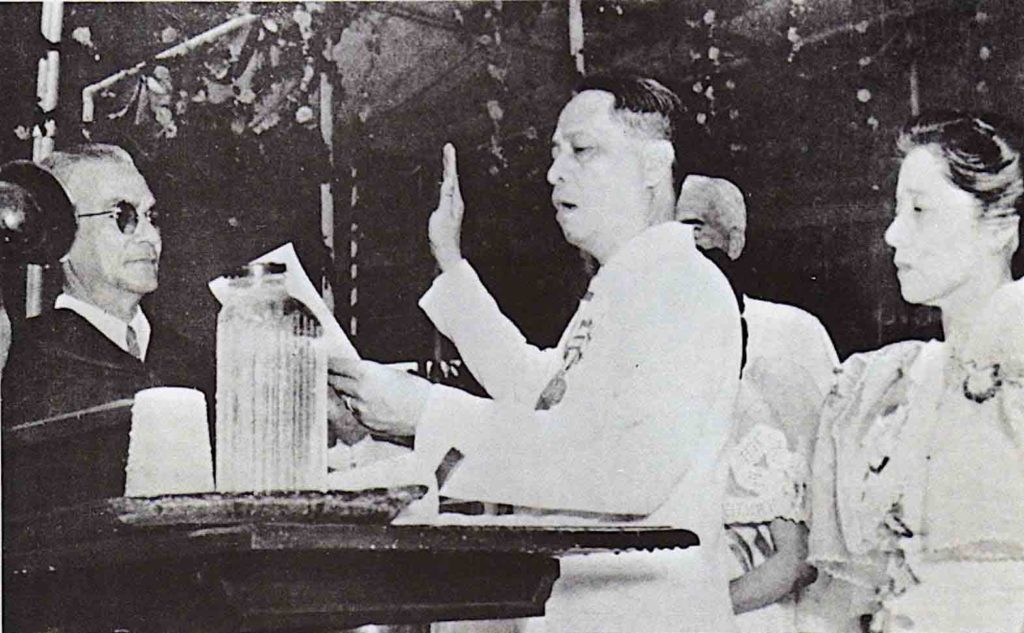A battered PH after World War II

Manuel Roxas swearing in as the first President of the Republic of the Philippines after WWII.
Imperial Japan agreed to an unconditional surrender to the Allies on August 15, 1945. The official surrender document was signed on September 2, 1945. After four arduous and deadly years, the brutality of World War II in the Pacific was finally over. The challenges of the aftermath of war now confronted the people of the Pacific.
The Philippines had one of the worse postwar conditions in Asia. It was estimated that one million Filipinos died during the years of fighting and Japanese occupation. The capital city of Manila was practically destroyed and would take years and much money to rebuild. The Philippines was originally scheduled to receive independence from the United States of American shortly, but there was worry that independence could be delayed because of the consequences of the war.
Among the first issues that the Philippines had to face were the trials of War Criminals. Lt. General Masaharu Homma was put on trial for his leadership during the barbaric Bataan Death March and the overall treatment of Filipino and American Prisoners of War. Homma was the commander of the Japanese Imperial Army in the Philippines from December 1941 to August 1942. He was found guilty of war crimes and executed on April 3, 1946.
The trial of General Tomoyuki Yamashita was another major war crime proceeding. Yamashita was the commander in the Philippines during the return of American forces in October 1944 until the surrender in August 1945. Although Yamashita had declared Manila an “Open City” and had ordered his soldiers to the mountains of Northern Luzon, he was still found guilty of the atrocities committed by the Japanese Imperial Navy in Manila. He was executed on February 23, 1946.
Another major issue was the treatment of Filipinos who had served in the Japanese occupation government. Many Filipinos considered them collaborators who deserved harsh punishment for their treason. The alleged collaborators argued that they were just following President Manuel Quezon’s directive to shield and protect the Filipino people. The counter argument was that the elite Filipino men who had served the Japanese occupation government were only interested in preserving and expanding their wealth.
The widely popular and revered General Douglas MacArthur intervened in this controversial collaboration issue. Many of the Filipinos who had served the Japanese were friends with the general before the war. He was very comfortable and supportive of Filipinos of substantial wealth. The general argued that men like his friend Manuel Roxas were actually double agents. Essentially, they served in the Japanese government to protect the Filipinos and at the same time they were providing valuable intelligence to American officers. MacArthur set a precedent for postwar political stability as he feared postwar communism. The needed social-economic changes in the Philippines took a back seat.
The biggest postwar priority was reconstruction. Japan was forced to pay reparations. The United States did provide millions of dollars in aid to its commonwealth in the Pacific, but the U.S. was accused of denying Filipino veterans United States Veteran Administration benefits.
The first postwar election for President of the Philippine Commonwealth was held on April 23, 1946. The incumbent president, Sergio Osmena, was challenged by Manuel Roxas. The election determined who would be the last President of the Commonwealth and the first President of the Philippine Republic once independence was granted by the United States. Manuel Roxas had a decisive victory in the election.
On July 4, 1946, the United States granted independence to the Philippines. The Philippines became the first Southeast Asian country to receive independence after World War II. Manuel Roxas was now the first President of the Republic of the Philippines.
The excitement of the transfer of power in the Philippines did not allay the massive rebuilding needs of the new republic. President Roxas was able to secure military and economic aid from the former colonist, but he had to make major military and economic concessions to the U.S. The United States was granted 99-year leases on many American naval and air force bases throughout the Philippine islands. It turned out that Japan had more favorable financial terms for base leases than the Philippines did.
President Roxas also agreed to a “parity agreement” that gave American businessmen in the Philippines the same rights as Philippine citizens in mining, forestry and extracting other raw materials. Essentially, the United States touted free trade, but the free trade mostly favored the United States.
Many historians have labeled this aftermath of World War II in the Philippines as neocolonialism. Of course, the United States granted independence to the Philippines and provided economic and military assistance to the new country. However, what were the social, economic, political and cultural costs to the Filipinos?
Dennis Edward Flake is the author of three books on Philippine-American history. He is Public Historian and a seasonal park ranger in interpretation for the National Park Service at the Eisenhower National Historic Site in Gettysburg, PA. He can be contacted at: flakedennis@gmail.com

